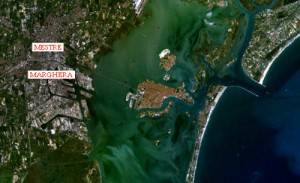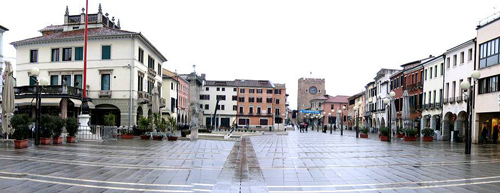
Mestre and Marghera
Mestre and Marghera represent the urban development of Venice, which is, by now, unable to expand beyond the natural borders imposed by the lagoon itself. From the administrative point of view they are a part of the lagoon town and represent its expansion on the dry land.
 The lagoon centre of Venice has got about 70.000 inhabitants, whereas Mestre and Porto Marghera are inhabited by about 200.000 people. The historical lagoon centre lives in the main on tourism, which is present during the whole year, whereas its part of dry land (Mestre) has developed thanks to the industrial pole of Marghera.
Nowadays Mestre and Marghera represent also a valid alternative for the tourist who does not want to spend too much but wants to visit Venice all the same.
By choosing of staying on the dry land it is possible to find easily a car park in the hotel area, instead of spending a lot of money in the Car Parks of P.le Roma.
If you want to reach the historical centre (that is the lagoon) you just have to catch a bus or a train and, crossing the Libertà Bridge, within fifteen minutes at the most, you can arrive at P.le Roma or at the Central Railway Station. From here, it is easy to reach, on foot or by a water-bus, the most important monuments of the town.
MESTRE
The lagoon centre of Venice has got about 70.000 inhabitants, whereas Mestre and Porto Marghera are inhabited by about 200.000 people. The historical lagoon centre lives in the main on tourism, which is present during the whole year, whereas its part of dry land (Mestre) has developed thanks to the industrial pole of Marghera.
Nowadays Mestre and Marghera represent also a valid alternative for the tourist who does not want to spend too much but wants to visit Venice all the same.
By choosing of staying on the dry land it is possible to find easily a car park in the hotel area, instead of spending a lot of money in the Car Parks of P.le Roma.
If you want to reach the historical centre (that is the lagoon) you just have to catch a bus or a train and, crossing the Libertà Bridge, within fifteen minutes at the most, you can arrive at P.le Roma or at the Central Railway Station. From here, it is easy to reach, on foot or by a water-bus, the most important monuments of the town.
MESTRE
 Before the magnificence of the lagoon centre, Mestre has played the role of a ‘cinderella’ for a long time, being a suburbs-town in opposition to the far more
prestigious historical centre. Yet, also Mestre, has got its interesting elements:
Ferretto Square: at first developed as the terminus of the tramway, then it acquired trade activities and the Toniolo Theatre. On the square there are also the Seventeenth century St. Lorenzo Dome and the Palazzo da Re, underneath the arcade of which the cereals market used to be held. The Clock Tower, at the end of the square, on the right end, dates back to 1108 and it was endowed with a clock during the Sixteenth century. Since 1998 the square has been made pedestrian and restored on a project of architect Guido Zordan. Half way the square a great fountain has been placed and in the middle of it there is an ormolu work by Alberto Viviani (1906-1989), from Mestre, one of the greatest sculptors of last century.
The two large town parks: Saint Giuliano Park, from which you cannot miss the wonderful view of the lagoon, and Albanese Bissuola Park.
The Forts, which represented the ancient outposts in defence of Venice, such as Marghera Fort, planned by the Austrians and built by the French people.
MARGHERA
Marghera was born as a workmen’s quarter but nowadays itis a very lively centre rich in green areas.
Before the magnificence of the lagoon centre, Mestre has played the role of a ‘cinderella’ for a long time, being a suburbs-town in opposition to the far more
prestigious historical centre. Yet, also Mestre, has got its interesting elements:
Ferretto Square: at first developed as the terminus of the tramway, then it acquired trade activities and the Toniolo Theatre. On the square there are also the Seventeenth century St. Lorenzo Dome and the Palazzo da Re, underneath the arcade of which the cereals market used to be held. The Clock Tower, at the end of the square, on the right end, dates back to 1108 and it was endowed with a clock during the Sixteenth century. Since 1998 the square has been made pedestrian and restored on a project of architect Guido Zordan. Half way the square a great fountain has been placed and in the middle of it there is an ormolu work by Alberto Viviani (1906-1989), from Mestre, one of the greatest sculptors of last century.
The two large town parks: Saint Giuliano Park, from which you cannot miss the wonderful view of the lagoon, and Albanese Bissuola Park.
The Forts, which represented the ancient outposts in defence of Venice, such as Marghera Fort, planned by the Austrians and built by the French people.
MARGHERA
Marghera was born as a workmen’s quarter but nowadays itis a very lively centre rich in green areas.